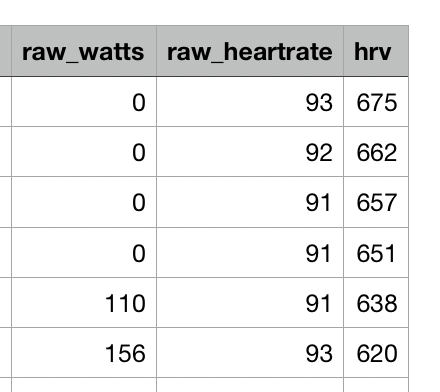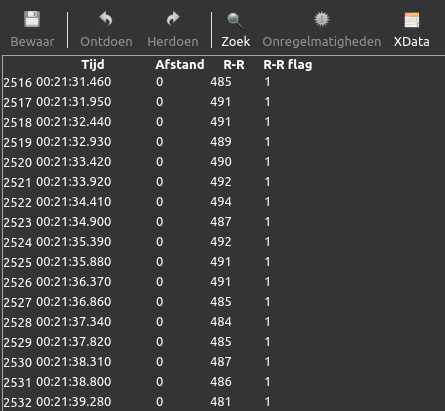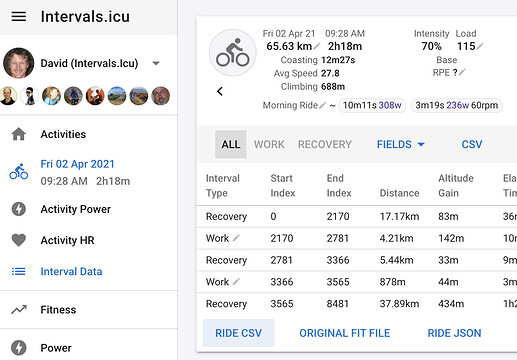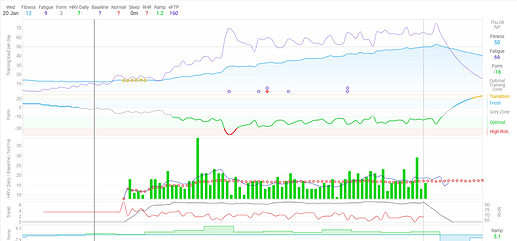Wahoo Roam can record HRV???
I’ve been measuring my HRV using three different apps (Android HRV4, Elite and Kubios of late: I never enter any “how do you feel today” info) as well as the amazing Kubios PC program for several years. Unfortunately I was out of things for a year due to a shoulder injury but I do use my HRV measurements to guide my training/ life intensity. If numbers are low, I go easy - a brisk walk, not jog (zone 2 stuff). For my bike, similar. And that’s my health/ training plan. The chart makes a lot of sense: though the ‘low’ and ‘high’ intensities may be better represented by ‘higher’ and ‘lower’.
*kubios app is fast becoming my favourite
**Decathlon store hr monitor works well, despite what some app-owners say, and is very cost effective.
I did the sam with my forerunner 735 and it worked too. I just need to get a decent HR strap now as the data quality from my old garmin one is shocking!
Intervals.icu now pulls HRV data out of .fit files if it is present. It doesn’t do anything with it yet but you can download it via the “Ride CSV” link on the activity data page. It’s not the same as the other streams in that it isn’t tied to the time stream. Its just a long list of “milliseconds between beats”.

Hi David
Is that the RR data stream from a fit file? If so I’ve done a bit of work on understanding this I can share with you.
Cheers
John
Thanks! Yes it is exactly that just in milliseconds. I have been looking at some of the DFA alpha 1 stuff. I will definitely ping you when I can get back to it. Right now this whole Garmin thing has pushed Dropbox to the top of the heap. But that shouldn’t take too long.
DFA a1 to get an accurate AT could really push intervals ahead of the competition and open up some great analysis opportunities. It doesn’t look like it should be too complex, although the hardware is still lacking somewhat.
Looking at that stream in Golden Cheetah, the timeline is made-up by adding all RR intervals. Which after all is logical but I don’t know how to handle missed beats. A missed beat would give a high RR interval and should be filtered out.

In the posts I have seen about this people us a ±25% or ±5% filter comparing each interval to the previous one to filter out artefacts. Apparently all of this stuff is very sensitive to artefacts.
Yes, still very much in the experimental stage. At one point Marco Altini was planning on building an app specifically to measure DFA a1 and report your LT1. He was going to call it HRV4Threshold. When I spoke with him he said he was putting it on hold given the challenges being uncovered with this approach. So many confounding factors. He was going to wait and see.
No, @Olly_Thomas - I use HRVLogger as well. This was another app he had planned to build specifically for DFA a1 measurement. He’s waiting for the work to mature and for those researching it to get a clear understanding of the factors that influence it. It’s worth remembering that the correlation between LT1 HR and a DFA a1 of 0.75 is purely coincidental - there is no physiological cause for it. Hence the need for much more experimentation / investigation and analysis.
I’ve never had much luck tying this to training (or how I’m feeling for that matter). I do tend to pay attention if I notice a downward trend over time though.
That HRV data as part of a workout… what apps / devices record that?
I measure HRV with Edge 130, but i think my Polar is an H11?
I’m using Edge 830 with Garmin Dual HRM. This week I connected the Garmin chest strap to the Edge by Bluetooth because apparently, the HR signal over Bluetooth is more reliable then ANT+ when it comes to recording R-R intervals. Read that on one of the blogs about dfa-a1:
https://the5krunner.com/2021/02/25/important-training-news-dfa-alpha-1-new-threshold-discovery-method-with-hrv/
Already tried a slow ramp test (6min steps of 4% FTP from 55-91%) for estimating VT1 that way but the result is rather uncertain, although the number of artifacts seems low. Tried post-ride calculation with Google Colaboratory link higher up this thread. It returns a VT1 HR of 131 which might be correct but the graph isn’t showing me a nice decline in dfa-a1 so I’m sceptical. I will try again later this week and crosscheck the results.
Anyway, this is all very new and needs more refining. The good thing is, that it is open to everyone.
I have read that this should be done with a ramp rate below 10W/min, but ideally 5W/min. Somewhere in this very informative blog post:
What did 4% every 6mins give you in terms of absolute ramp rate?
For my part, I have tried a 5W/min and 10W/min ramp rate. The 5W/min ramp gave me reasonable results - with 0.7 correlation coefficient between DFA-alpha1 and HR (data filtered for artefacts) during the ramp portion of my activity. The 10W/min ramp gave me junk though! Effectively no correlation at all (0.2 correlation coefficient).
I think I will try that 5W/min ramp again next time I test to see how my results compare. But to be honest 0.7 correlation is still quite weak so I will also consider different protocols to the ramp test that I’ve been doing - from 100W to failure which takes a long time!
I’ve deployed HRV for myself with a medical-grade ECG , and curiously monitoring and studying signals over last 4 years. So this tugs at my interest.
One thing I can tell you is that spot checks everyday may not be nearly as instructive as “trends” over longer time spans. Spot checks will have you being very reactive to what the app is showing you. Sometimes that can be disruptive to a plan you have already made. Not every dip in HRV demands an immediate reaction from the owner of the heart 
A longer term downward trend over 3-4 days outside of normal variability bounds, OTOH, might be indicative that something negative is happening, an impending illness for example…OR an NFOR scenario.
Secondly, the paper is proposing this scheme for professional athletes. This segment of the population often have low resting heart rates to begin with. Despite training and adapting well, the bradycardia leads to a phenomenon called saturation, which can also bring down HRV. I wonder how the authors propose dealing with this.
H10 strap is the most accurate for measuring HRV of any strap. On HRV4Training app they bluetooth to the H10 for “device” based measurements instead of camera based measurement!
I’ve setup this on the Fitness page:
Inspired on Marco Altini’s way of monitoring rest HRV.
The green bars are daily RMSSD. The dark blue line is a 7 day rolling average of RMSSD and gives you short term trend. The red dots are 42 day average for a long term trend. That last one should actualy be 60 day rolling average with tolerance of 75% of the Standard Deviation but that’s not possible in intervals right now. This tolerance band is considered your “normal values”.
Combined with training load, sleep quantity/quality and other influencers, this chart can give you some insight.
4% turns out about 8W for me. So I guess 8W steps every 6 min should be good as protocol. But it could just be my Garmin Dual chest strap that isn’t good enough for this kind of testing. Hard to say. Not enough details for now, I will test again and see if anything turns up.

